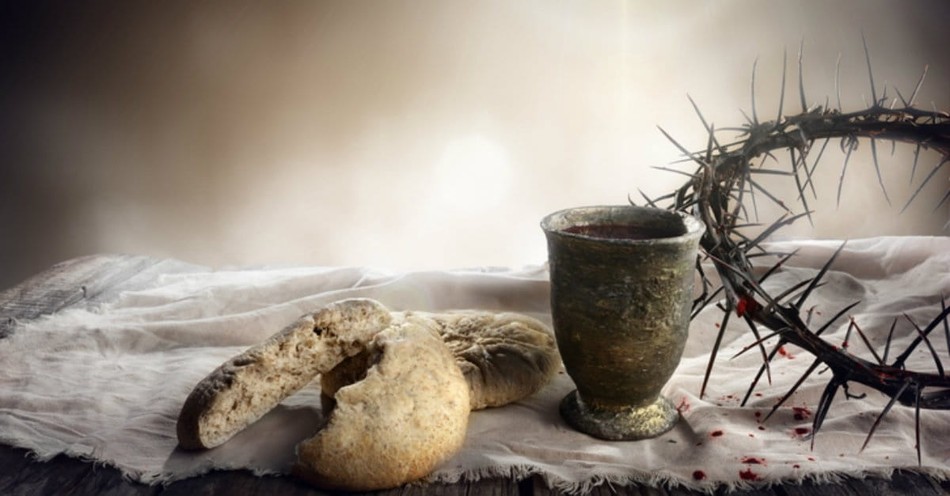The Last Supper, which took place hours before the Lord’s crucifixion—was a Seder (Passover observance). Previously, the feast’s symbols had only pointed back to the Hebrews’ redemption from Egypt. But that Thursday night, Jesus revealed the messianic significance of two symbols: bread and wine.
What is Passover Seder?
In a Seder, a cloth bag with separate compartments holds three sheets of matzoh, or unleavened bread. The middle matzoh is removed and split. One half is broken and distributed; the other is wrapped in a napkin, hidden, and bought back after it is found.
Get your FREE Holy Week Guide here. Have encouragement delivered straight to your inbox!
Symbolism of Bread in the Last Supper
Breaking the bread, Jesus said, “Take, eat; this is My body” (Matthew 26:26). In Scripture, leaven symbolizes sin, so bread without yeast represents holy God.
In the divided bag, matzohs are unified yet distinct—a picture of the Trinity. The middle bread signifies the Son, who left His Father’s side to dwell among us (Galatians 4:4) and was broken for mankind (Isaiah 53:5), wrapped in a burial cloth (Matthew 27:59), hidden in a tomb (v. 60), and resurrected (28:6). Our redemption was, indeed, costly (1 Corinthians 6:20).
Symbolism of Wine in the Last Supper
Wine, the other symbol Jesus highlighted, is poured four times at a Seder. Scholars believe it is the third cup—known as the cup of redemption—that He called “My blood of the covenant, which is poured out for many for forgiveness of sins” (Matthew 26:27–28).
When speaking about Jesus, follow His example of meeting people where they are in their understanding and then leading them to deeper awareness. And as you next take Communion, look back on what Christ did for you, look forward to His return, and remember He is our Passover (1 Corinthians 5:7).
Symbolism of Commitment in the Last Supper
Jesus’ blood cleanses us of sin. Starting with Adam and Eve, God required a blood sacrifice to cover transgressions (Genesis 3:21; Leviticus 17:11). But this was just a temporary solution, as the next offense required another sacrifice. Jesus was God’s permanent answer to the problem: He took upon Himself all sin - past, present, and future - and died to pay the full penalty.
When a believer receives salvation, he is consecrated - or set apart to the Lord. His sin is forgiven, and he receives eternal life as well as the indwelling Holy Spirit. But if he at times forgets that he belongs to the Lord, he may give in to temptation. The bread and the cup provide an opportunity to remember what the Father expects of His children and to renew one’s commitment to obey.
This section is an excerpt from this article by Charles Stanley.
Symbolism of Communion in the Last Supper
The Lord’s Supper is also a time to be in communion. We are connected not only with the Lord who saved us but also with past and present believers. Among members of God’s family, we find comfort and support, just as the disciples and the early church did.
The Lord’s Supper is a good time to stop and recall what Jesus has given us. Partake solemnly and gratefully.
This section is an excerpt from this article by Charles Stanley.
Purpose of the Lord’s Supper: A Proclamation of the Gospel
Read along with the transcript below of this video by Mike Bullmore:
Yeah, the purposes of the Lord's Supper, without question, the primary reference of the Lord's Supper is to the death of our Lord. We hold in our hands these precious symbols, the broken bread, symbolizing the body given, Christ's body, His real body, given for us, and the cup, representing His shed blood. So clearly the reference, the primary reference is to the death of Christ. And Paul in the most extensive teaching in the New Testament about the Lord's Supper, 1 Corinthians 11, gives very practical counsel about how to do this, what this should look like in the church, but also speaks about the purposes of the Lord's Supper.
So the primary purpose is this proclamation, "Do this in remembrance of Me," and as often as you do it, you proclaim the Lord's death. So the primary purpose of the Lord's Supper is really a proclamation, again, of the gospel, not so much to unbelievers as it is what a wonderful opportunity when we gather together as believers to preach the gospel to ourselves, not only this proclamation of Christ's death, but there's also this anticipatory purpose of the Lord's Supper. Remember, he said, "You proclaim the Lord's death until He comes," kind of picking up what Jesus said at the Last Supper, "I'm not going to eat this again until I eat it with you in the kingdom of heaven." And so we're looking back to Christ's death, but also looking forward in anticipation to what Christ's death purchased for us, this promise of life in God's presence.
And then I think in a piece that we cannot forget, so yes, proclamation, anticipation, but in the present, this is not so much in 1 Corinthians 11, as it is in 1 Corinthians 10, Paul talks about communion, participation with the Lord. And so there is this present communion, not in some unusually mysterious way, it is a communion of fellowship with Christ, with God in Christ, an experience of what Christ purchased for us, this close family table fellowship with God in Himself. That's the primary reference, I think, of the Lord's Supper.
Paul does add one other piece, which I think is important, in 1 Corinthians 10, this reference to our unity. He says, "Is there not one bread that you take," speaking of the unity of the body. And so not only does it function to point us, again, to Christ's death, but it points us to the unity of what Christ's death purchased, the body of Christ. We eat together. So these are the purposes, I believe, of the Lord's Supper.
Purpose of the Lord’s Supper: A Covenant Renewal Ceremony
Read along with the transcript below of this video by Tim Keller:
My understanding is that the Lord's supper is a covenant renewal ceremony. It is a place in which people who've been saved by the Gospel, remember the Gospel. It's a reenactment of the Gospel. And in the Old Testament, a covenant renewal ceremony was a time in which the people would remember what God had done for them, rehearse the events of salvation history and renew their vows.
I actually believe the Lord's supper is a covenant renewal ceremony along the same lines. As a Presbyterian, I also believe that the Lord's supper brings a grace, a particular grace from God that doesn't come when you're just praying, and therefore it's a covenant renewal ceremony that really helps us participate in the grace and strength and joy of God in a unique way.
Charles Stanley excerpts taken from “Christ’s Last Supper” by In Touch Ministries (used by permission).
Further Reading:
25 Best Communion Bible Verses
What Is Holy Communion? Bible Meaning, Verses, and Modern Forms
Communion Prayers to Give Thanks for the Lord's Supper
Why Is There So Much Disagreement about Holy Communion?
Photo Credit: ©Thinkstock/RomoloTavani
Learn more about the meaning and significance behind the Easter holiday and Holy Week celebrations:
What is Lent? and When Does Lent Start?
What is Ash Wednesday? and When is Ash Wednesday?
What is Palm Sunday?
What is Maundy Thursday?
What is Good Friday? and When is Good Friday?
What is Holy Saturday?
What is Easter? and When is Easter Sunday?
Easter Bible Verses
The Resurrection of Jesus
Easter Prayers


.jpg)
